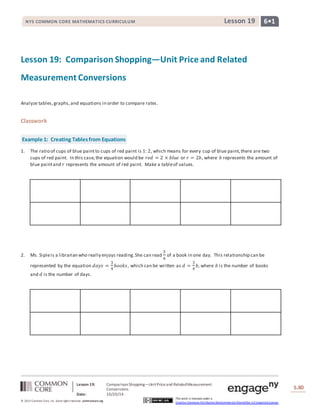Weitere ähnliche Inhalte
Ähnlich wie G6 m1-c-lesson 19-s (20)
G6 m1-c-lesson 19-s
- 1. NYS COMMON CORE MATHEMATICS CURRICULUM Lesson 19 6• 1
Lesson 19: Comparison Shopping—Unit Price and Related
Measurement Conversions
Lesson 19: Comparison Shopping—Unit Price and Related Measurement
Conversions
Date: 10/20/14
S.80
© 2013 Common Core, Inc. Some rights reserved. commoncore.org
This work is licensed under a
Creative Commons Attribution-NonCommercial-ShareAlike 3.0 Unported License.
Analyze tables, graphs, and equations in order to compare rates.
Classwork
Example 1: Creating Tables from Equations
1. The ratio of cups of blue paint to cups of red paint is 1: 2, which means for every cup of blue paint, there are two
cups of red paint. In this case, the equation would be 푟푒푑 = 2 × 푏푙푢푒 or 푟 = 2푏, where 푏 represents the amount of
blue paint and 푟 represents the amount of red paint. Make a table of values.
2. Ms. Siple is a librarian who really enjoys reading. She can read
3
4
of a book in one day. This relationship can be
represented by the equation 푑푎푦푠 =
3
4
푏표표푘푠, which can be written as 푑 =
3
4
푏, where 푏 is the number of books
and 푑 is the number of days.
- 2. NYS COMMON CORE MATHEMATICS CURRICULUM Lesson 19 6• 1
Lesson 19: Comparison Shopping—Unit Price and Related Measurement
Conversions
Date: 10/20/14
S.81
© 2013 Common Core, Inc. Some rights reserved. commoncore.org
This work is licensed under a
Creative Commons Attribution-NonCommercial-ShareAlike 3.0 Unported License.
Exercises 1–3
1. Bryan and ShaNiece are both training for a bike race and want to compare who rides his or her bike at a faster rate.
Both bikers use apps on their phones to record the time and distance of their bike rides. Bryan’s app keeps track of
his route on a table, and ShaNiece’s app presents the information on a graph. The information is shown below.
Bryan: ShaNiece:
Hours 0 3 6
Miles 0 75 150
a. At what rate does each biker travel? Explain how you
arrived at your answer.
.
b. ShaNiece wants to win the bike race. Make a new graph to show the speed ShaNiece would have to ride her
bike in order to beat Bryan.
- 3. NYS COMMON CORE MATHEMATICS CURRICULUM Lesson 19 6• 1
2. Braylen and Tyce both work at a movie store and are paid by the hour. The manager told the boys they both earn
the same amount of money per hour, but Braylen and Tyce did not agree. They each kept track of how much money
they earned in order to determine if the manager was correct. Their data is shown below.
Braylen: 푚 = 10.50ℎ where ℎ is the number of hours worked and 푚 is the amount of money Braylen was paid
Lesson 19: Comparison Shopping—Unit Price and Related Measurement
Conversions
Date: 10/20/14
S.82
© 2013 Common Core, Inc. Some rights reserved. commoncore.org
This work is licensed under a
Creative Commons Attribution-NonCommercial-ShareAlike 3.0 Unported License.
Tyce:
Hours 0 3 6
Money 0 34.50 69
a. How much did each person earn in one hour?
b. Was the manager correct? Why or why not?
- 4. NYS COMMON CORE MATHEMATICS CURRICULUM Lesson 19 6• 1
3. Claire and Kate are entering a cup stacking contest. Both girls have the same strategy: stack the cups at a constant
rate so that they do not slow down at the end of the race. While practicing, they keep track of their progress, which
is shown below.
Lesson 19: Comparison Shopping—Unit Price and Related Measurement
Conversions
Date: 10/20/14
S.83
© 2013 Common Core, Inc. Some rights reserved. commoncore.org
This work is licensed under a
Creative Commons Attribution-NonCommercial-ShareAlike 3.0 Unported License.
Claire:
Kate: 푐 = 4푡 where 푡 = time in seconds
and 푐 = the number of stacked cups
a. At what rate does each girl stack her cups during the practice sessions?
b. Kate notices that she is not stacking her cups fast enough. What would Kate’s equation look like if she wanted
to stack cups faster than Claire?
- 5. NYS COMMON CORE MATHEMATICS CURRICULUM Lesson 19 6• 1
When comparing rates and ratios, it is best to find the unit rate.
Comparing unit rates can happen across tables, graphs, and equations.
Lesson 19: Comparison Shopping—Unit Price and Related Measurement
Conversions
Date: 10/20/14
S.84
Lesson Summary
© 2013 Common Core, Inc. Some rights reserved. commoncore.org
This work is licensed under a
Creative Commons Attribution-NonCommercial-ShareAlike 3.0 Unported License.
Problem Set
1. Victor was having a hard time deciding on which new vehicle he should buy. He decided to make the final decision
based on the gas efficiency of each car. A car that is more gas effic ient gets more miles per gallon of gas. When he
asked the manager at each car dealership for the gas mileage data, he received two different representations, which
are shown below.
Vehicle 1: Legend Vehicle 2: Supreme
Gallons of Gas 4 8 12
Miles 72 144 216
a. If Victor based his decision only on gas efficiency,
which car should he buy? Provide support for your
answer.
b. After comparing the Legend and the Supreme, Victor saw an advertisement for a third vehicle, the Lunar. The
manager said that the Lunar can travel about 289 miles on a tank of gas. If the gas tank can hold 17 gallons of
gas, is the Lunar Victor’s best option? Why or why not?
